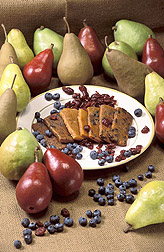This page has been archived and is being provided for reference purposes only. The page is no longer being updated, and therefore, links on the page may be invalid.
|
Read the magazine story to find out more. |
Pear Bars Capture Orchard-Fresh FlavorBy Marcia WoodDecember 12, 2002 Pear bars, a tasty new treat from Agricultural Research Service scientists and pear growers in the Pacific Northwest, capture the fresh flavor of this favorite fruit. The all-fruit, all-natural bars stay soft and chewy without the need for artificial preservatives. ARS food technologist Tara H. McHugh at the agency's Western Regional Research Center, Albany, Calif., worked with colleague Charles C. Huxsoll, formerly an agricultural engineer at the Center and now retired, to develop the technology for making a 100-percent fruit bar. McHugh is leader of the Processed Foods Research Unit at Albany. The bars, about the size of a typical granola bar but a bit slimmer, will be made and marketed by HR Mtn. Sun, Inc., of Hood River, Ore. The company has a license for the technology from the U.S. Department of Agriculture. Under terms of a Cooperative Research and Development Agreement, company specialists are working with McHugh's team to study the storage properties of the pear bar and ready the food-making process for production. Plans call for the pear-bar product line to include not only a rich, all-pear bar--with bits of dried, diced pears for added texture--but also a flavorful pear-blueberry bar and a zesty pear-cranberry bar. All will be a boon to the region's producers, as well as to consumers looking for a new way to enjoy these perishable fruits year-round. The technique for producing the bars is fast, easy, energy-efficient and relatively inexpensive, according to McHugh. First, pears are processed into puree and concentrate to capture their freshness and flavor. After the rush to ship fresh-market pears to buyers nationwide and overseas subsides, the puree is either spray- or drum-dried, then mixed with the concentrate. Next, the mixture is shaped into bars using a standard piece of food-processing equipment known as an extruder. McHugh and Huxsoll have received a patent for their invention. Like fresh pears, pear bars provide fiber, vitamin C and several minerals, including iron and potassium. Details are in the December issue of Agricultural Research magazine. ARS is the USDA's chief scientific research agency. |

